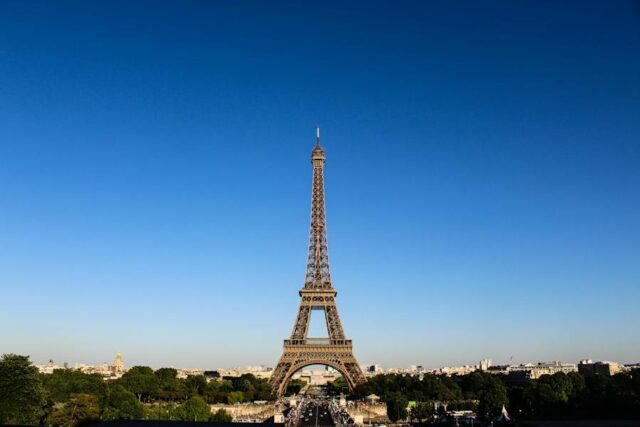You could have noticed a slight difference and wondered, does the Eiffel Tower grow? The Eiffel Tower is the crown of Paris, and everyone visiting the city has to admire its grandeur.
It has been the centre of many myths and conspiracy theories, and this article will debunk all of them.
One of the most commonly talked about theories is that the Eiffel Tower has grown and is increasing since it was created.
We need to explore the physics and engineering of how the Eiffel Tower was built to see whether or not this is true. The more knowledge you have, the better, so here are all the facts;
Does The Eiffel Tower Grow?
The tower is made of metal, so it expands slightly when the heat increases, creating a height fluctuation of about 6 inches in summer.
The Eiffel Tower is a marvel of engineering, and it expands and contracts depending on the weather. It will reduce when it gets cold in winter, so it is the same size in the end, and the changes don’t affect its structural integrity.
Understanding The Changes In The Size Of The Eiffel Tower
The first reason why the Eiffel Tower has gotten taller is because it was used as a radio antenna. The Eiffel Tower was the tallest structure for a long time, making it an ideal spot to install a radio antenna for televisions around Paris, increasing its summit.
Aside from this, the Eiffel Tower gains and loses a few centimeters each year, and it has grown a little from when it was created.
The Eiffel Tower was launched in March of 1889 under the name “The 300-meter Tower,” which adequately described what it was and its size.
It had an original height of 312 meters, making it the tallest tower in the world for the next 42 years until the Empire State Building was constructed. The Eiffel Tower has continued to grow since then and is currently 330 meters, including the antennae.
Another reason why the Eiffel Tower is also so impressive and has stood for so long is because it changes with its environment’s weather conditions.
The Eiffel Tower was constructed to withstand heat, snow, rain, wind, frost, and other weather elements, and the best material for this at the time was puddled iron. Puddled iron is sensitive to temperature changes and reacts to the heat in summer and cold in winter.
From science class, you know that matter expands when temperature increases, and the same applies to the puddled iron in the tower. During summer, the heat warms up the Eiffel Tower, increasing in size because of thermal expansion.
The increase is minor within the molecules and will manifest as an increase of a few inches on the tower. This also causes a slight tilt as the sun heats only one side of the Eiffel Tower, so it bends away from the sun as that side has slightly more expansion.
This uneven heat creates an imbalance with the stable sides, making the tower lean. Because of this phenomenon, the top of the tower moves in a circular curve of about 15 cm in diameter, depending on how hot the day is.
The opposite also applies during winter when the metal gets cold. It reduces in size and the tower will lose a few millimeters.
These changes are a natural part of metals and other forms of matter, and they don’t affect the integrity of the Eiffel Tower since they self-correct.
It is also impossible for an observer to see these changes from looking at the tower. You will, however, notice vibrations or slight shaking when there are high winds, but it will not damage the tower.
The tower’s creators put a lot of thought into creating it to make it more wind-resistant, but sometimes the weather gets brutal. In such cases, the authorities will close the top half or the whole tower to keep employees and civilians safe.
How Was The Eiffel Tower Built?
The Eiffel Tower’s historic building design and speed made it a marvel. The tower’s construction commenced with the digging work for the foundations in January of 1887, and the entire tower took only two years, two months, and five days.
The thought of creating the Eiffel Tower came up between two engineers, Emile Nouguier and Maurice Koechlin, in 1884. They both worked at Eiffel’s company and believed a tall tower would be an outstanding attraction.
They added an architect, Stephen Sauvestre, to their group to help them create a design that would appeal to the people and generate interest from the public. Stephen implemented the tower’s beauty and outlook, such as the large arches that support it.
The engineers had difficulty calculating to ensure the building could support its weight and remain wind-resistant.
A crucial part of this is a strong base so the uprights of the tower rest on a concrete foundation that sits on compacted gravel.
Each tower corner has its block to provide independent support and make the structure sturdier. The Eiffel Tower comprised parts created by the Eiffel Company outside of Paris and then joined at the site.
Daily teams of between 150 and 300 workers assembled the pieces and secured all metal components with rivets.
The massive structure needed four men to install each rivet. One person held it in place, another heated it, a third person shaped its tip, and the last hit it into place with a sledgehammer. The site used about 2,500,000 rivets, with 1/3 used in joining at the site.
This creation system is part of why the Eiffel Tower was able to be constructed so fast. The company mass-produced parts and quickly joined together at the site. By 1889, the project was done and ready to be opened to the public.
The tower had a reddish-brown color during its launch in 1889, but they later changed it to yellow. It remained yellow-brown before it finally changed to its signature brown. The tower gets a paint job every seven years, which takes about 60 tons of paint.
They used three shades of color as you go higher on the tower to enhance its aesthetic and make it stand out more. The tower has become an important tourist attraction that has withstood the test of time.
Why The Eiffel Tower Was Built and Its Current Significance
The Eiffel Tower cost much money and manpower, especially with the little technology. It was important for the Eiffel Company and the people of Paris. So what was the reason for this effort, and what value does the tower carry today?
Many people think the Eiffel Tower was a gift to France from another country, but this is inaccurate. The tower’s original purpose was to serve as the World Fair’s centerpiece in Paris, and it was supposed to be the main attraction from 1889.
It was supposed to showcase the ingenuity and mechanical prowess of the French on the world stage, and it did this for over four decades. It commemorated the French Revolution, built a century after this pivotal moment in French history.
The original plan was to destroy the tower after 20 years, but its growing popularity and the wireless antenna on top of it made the government keep it. As it stayed up longer, it became a more significant part of Paris and France and is currently one of its most prominent landmarks.
The tower is a true testament to French artistic prowess and engineering and has become an identifier for the country. During World War II, the Eiffel Tower was a crucial transmission point that allowed the French to communicate with their troops and allies.
The Germans also used the tower to jam radio signals and prevent communications when they had taken Paris. Despite this, it endured the War and grew to become one of the most popular tourist attractions in the world.
Millions of people come to see the tower, and some suggest that more than 300 million visitors have visited the Eiffel Tower since 1889. Its popularity has boosted the French economy as visitors fly around the globe to see it and Paris.
It is a symbol of romance that couples fly thousands of miles to see or give proposals at. This significance makes it a historic landmark and an essential part of world history.
Conclusion
Hopefully, you better understand the Eiffel Tower’s enigma, and you can answer the question, “Does the Eiffel Tower grow?” This is one of the most common theories about the Eiffel Tower, and some truth supports it because it is made of metal.
As the heat increases and warms up the metal, the tower grows a little taller, but winter has the opposite effect and reduces its size. The Eiffel Tower has become an essential part of French history and is now the country’s most recognizable symbol.














